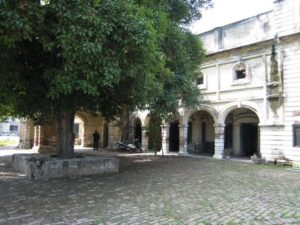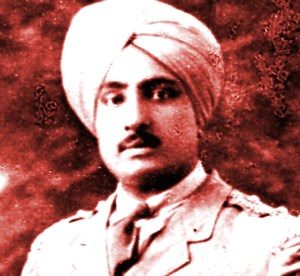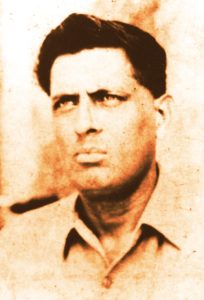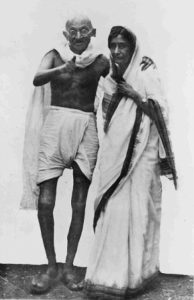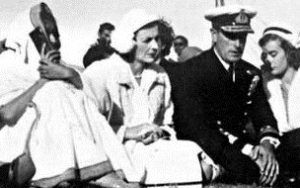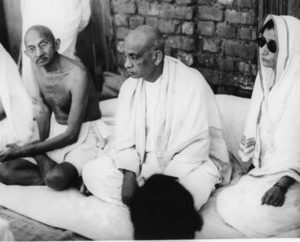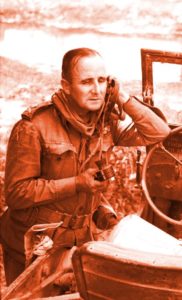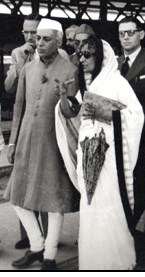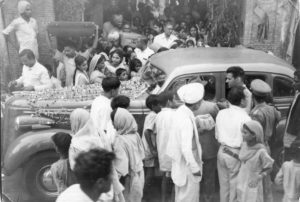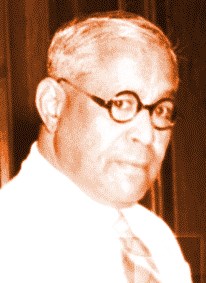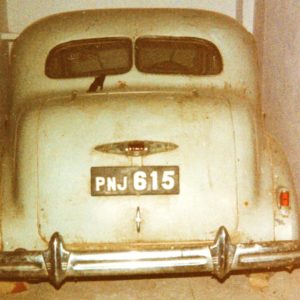The 615 Express
Even for the incredibly violent 20th century, the partition of India in 1947 stands out as an unparalleled human tragedy.
The largest case of forced human migration in history displaced more than 27 Million people. It resulted in the rape, abduction or murder of millions of Hindus, Sikhs, Muslims, Christians and people of many other races and creeds.
Quit India
The “Quit India” independence movement led by Mahatma Gandhi had been amazingly successful and had over the years slowly chipped away at the very concept of the British Raj not only in India but also in the minds of the British public
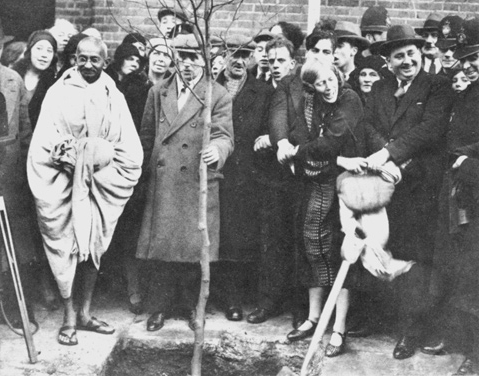
Gandhi in East London Dec, 1931
By the early 1940s even a large percentage of the British public was with the Mahatma in his quest for the independence of India.
The end of the war saw Great Britain hugely in debt and facing widespread social upheaval within the British society.
Finally the shock defeat of Winston Churchill and the victory of the Labour party in the general election of July 1945 brought home the final realisation that the British could no longer hold on to the Raj.
The priority for the new labour government at the time was simply to get out of India as fast as they could and not waste any of their precious resources, trying to manage the increasingly troublesome colony.
To be frank, at the time the British Government could care less as to what would happen to all of the people in the subcontinent after their departure.
Ludicrous deadlines were set for the passing of the power from the British to the governments of the two new nations by the well intentioned but totally naive leaders on all sides.
It is by their reckless negligence and total indifference to the potential consequences of leaving in such haste, that the British are culpable for not only the holocaust that followed the partition, but also for many serious unresolved problems such as Kashmir, which have had devastating global impact through the annals of time.
The Partition
The idea of the division of the post British India in to Muslim and Non-Muslim parts was put forward by a small group of radical Muslims in the 1930s and this divisive concept had grown much stronger by the early 1940s.
As the voices of separation became louder, many Muslim, Hindu, Sikh and Christian leaders had fought strongly against it.
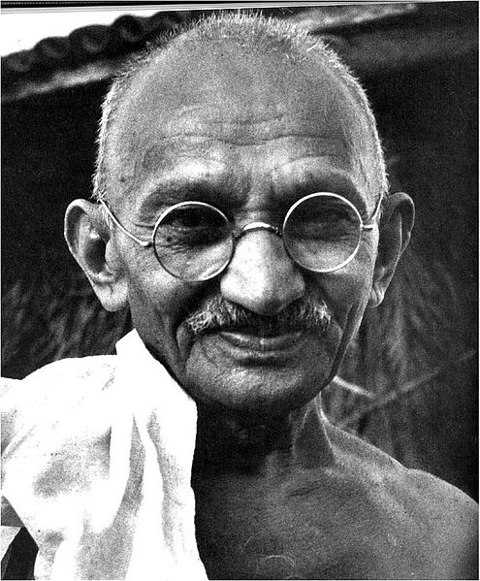
Mahatma Gandhi was against the division of India
Mahatma Gandhi who had almost single-handedly forced the British out of India, was totally against the division of India into Muslim and Non-Muslim Nations.
In addition, many of the notable leaders of all of the communities in India, such as Sir Sikandar Hyat Khan, Sir Khijar Hayat Tiwana, Kanwar Jasjit Singh of Kapurthala and Harkishan Singh Surjeet were some of the strong voices calling to keep the independent India together as a single entity.
However, the idea of the partition of India into Muslim and Non-Muslim sections was being driven forward by irresistible political and historical forces and could not be stopped.
Long standing ethnic conflicts over the last few hundred years in the history of India played a very important part in the division of the Greater India as well.
The Muslims, who had ruled large parts of India for several hundred years before the arrival of the British, felt that they should get to rule the entire country after the departure of the British from India.
It was clear however that the Non-Muslim majority in the post British India would not allow that to happen.
Punjab, one of the most fertile and the most prosperous region of India was proposed by the Muslim leaders such as Jinnah to be the heart of the new Muslim Nation. The problem with that was that the Sikhs, for whom Punjab was their spiritual home, would have never given up their homeland.
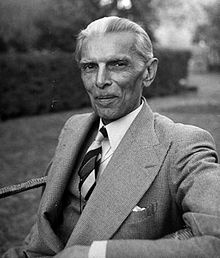
Muhammad Ali Jinnah
Initially Jinnah tried to woo the Sikhs to get them to agree to join the new Muslim Nation, promising that the Sikhs would be able to practice their religion freely in the new country of Pakistan, which was to have Islam as its officially declared religion.
Muhammad Ali Jinnah used his close friendship with Kanwar Jasjit Singh of Kapurthala to try and persuade him to help in getting the Sikhs to join the new country of Pakistan.
Kanwar Jasjit Singh reminded Jinha that the Sikhs had relatively recent memories of the “Ghallugharas” – the Great Sikh Holocausts – at the hands of Muslims and would never agree to live in an Islamic nation.
For over 300 years, during the 17th, 18th and the 19th centuries, the Muslims rulers in India had made several attempts at the racial genocide of the entire Sikh race, with repeated massacres of a vast number of Sikh men, women and children.
The two younger sons of Guru Gobind Singh Ji, the last Guru of the Sikhs, little Fateh Singh who was under Six years old and Zorawar Singh who was just over eight years old, were bricked alive in December 1705 by Wazir Khan, the Nawab of Sirhind, for refusing to convert to Islam.

Zakraya Khan, the governor of Punjab (1726-1746) had even made his state policy to exterminate all the Sikhs & to wipe out Sikhism from the pages of history.
These repeated holocausts and other atrocities at the hands of the Muslims loomed large in the racial memory of Sikhs, making it impossible for them to agree to live in an Islamic country.
So the Sikhs refused to live in a country where Islam was to be the official religion, even though Jinnah had promised that Sikhs would not be persecuted by the Islamic authorities in Pakistan and would have the right to worship according to their traditions.
At the same time, the Muslims were equally fearful of a Hindu majority in the new India and so in their millions, they decided to move to Pakistan.
In fact there was mutual suspicion on all sides, as all of the ethnic communities held real and imagined grievances against each other.
That is how India, the greatest melting pot of races and religions ever known, drifted slowly towards the breakup of its ancient lands.
The inevitability of the partition of India was clear for all to see by 1945.
Cyril Radcliffe (later Sir Cyril Radcliffe) the Chairman of the Border Commission was given the job of dividing the Greater India in to two countries.

Cyril Radcliffe
In a curious example of British sense of irony, his main qualification for the task was that Radcliffe had never been to India, did not like India and in fact did not know anything at all about the country and its people.
The idea being that his very ignorance of all of the parties involved, would produce an impartial result.
On top of that, Radcliffe had just a very short period of time to unravel hugely complex cultural, linguistic and religious relationships of the varied people of India with their cities and villages, that had developed over thousands of years!
So the infamous “Radcliffe Line” was conceived, splitting India in to pieces.
The ancient land of the Vedas, with its history going back to over 12000 years, was carved up in a botched up political cesarean section, giving birth to the fledgling new countries of India and Pakistan.

The Radcliffe Line (s)
In an astonishing act of political naivety by all involved in the geographical butchery, the new Islamic country of Pakistan was created in two parts, an area of Punjabi Muslim majority in the East and the second part, which was mainly Bengali Muslims in the West.
The new Muslim Nation of Pakistan therefore straddled the multi-racial and secular India, manifesting itself on its Eastern and also on its Western border!
Officially announced in August of 1947, there was never a line drawn on paper so drenched with human blood and misery as the “Radcliffe Line”.
The riots and the mass killings had not waited for the Radcliffe line though and the ethnic massacres had started all over India well before that time.
As early as 1945, Lord Wavell, the then Viceroy of India had disclosed what he called were “Confirmed Genuine Muslim Areas in Punjab and Bengal.” This inevitably started instant ethnic riots within those provinces.
Tens of thousands of Hindus, Muslims, Buddhists Sikhs and Christians were killed as all of the local communities thus effected, started driving out by force from their areas, all those who “did not belong”.
Thus started the greatest mass ethnic cleansing the world has ever known.
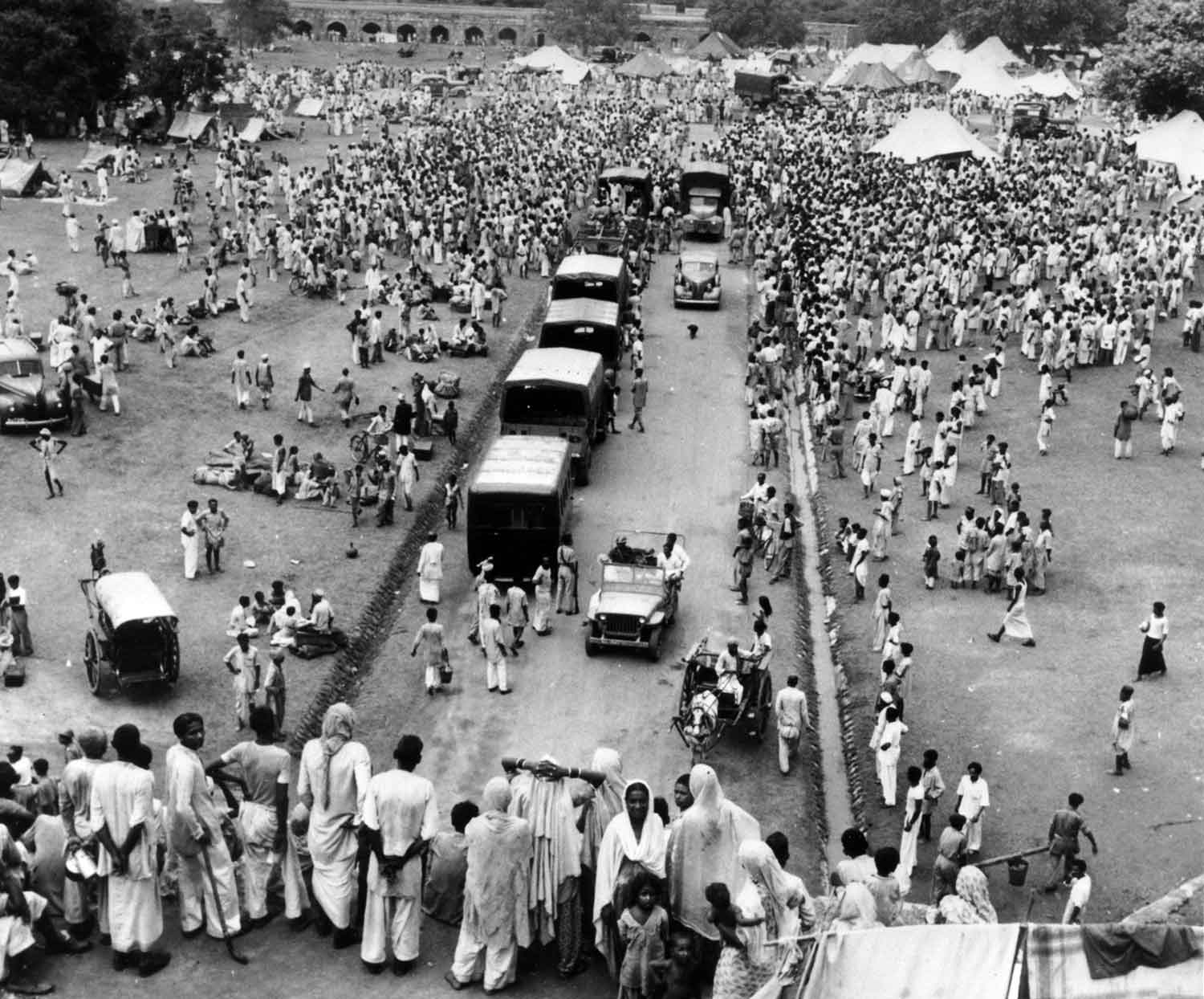
Tens of Millions forced to leave their homes
A huge number of Muslims were stranded on the wrong side of the newly created borders and were in mortal danger from the militant Sikhs and Hindus, in what was now widely expected to be the new secular India.
Also, tens of Millions of Non-Muslims found themselves on the wrong side of the new border to be, in the areas which were to be designated as East or the West Pakistan, facing increasing hostility from the Muslims in those areas.
By the year 1946, the break up of India in to a Muslim and a Secular nation was a reality for most people.
The Mega Holocaust
No one knows who started the tit for tat massacres, but it soon turned in to the slaughter of entire villages and towns on both sides of the border, with indescribable acts of cruelty.
The ethnic killings had been going on for a while but the end of the year 1946 saw major coordinated attacks on the Sikhs in the “Muslim Punjab”, in and around Rawalpindi, which had been designated as part of the new country of Pakistan.
The leaders of the Muslim League incited Muslims every where to murder and drive out Hindus and Sikhs.
Zafar Ali Khan, proprietor of the Daily Zamindar of Lahore, published his paper on the 5th September with a highly inflammatory poem against the Sikhs on the front page of the paper, the last and telling line of which was: Koi Sikh rehne na pae Maghribi Punjab men” (Let no Sikh be allowed to remain in Western Punjab).
There was no protection for the non Muslims any where in Pakistan as the Muslim Police actually abetted and aided attacks on Hindus, Sikhs and other non Muslim people.
I believe that there is a FaceBook page for the high school in Thoha Khalsa, in the province of Rawalpindi in the current day Pakistan. I wonder if the young students of the high school Thoha Khalsa know anything at all about the bloody history of the place that they live in.
On the 8th of March 1947, the village of Thoha Khalsa, mainly inhabited by Sikhs, most of whom were Goldsmiths and Jewellers, was attacked by thousands of heavily armed Muslims. The Sikhs of Thoha Khalsa, who were outnumbered 800 to 1, had no choice but to put up a to-the-death-fight.
Surrounded from all sides by a very large number of attacking Muslims, the Sikhs created a circular defense around the village well.
The Sikh men and the male Sikh children – recorded to be as young as 9 years old – faced the attacking Muslims in a circle with their backs to the village well, with the Sikh women, younger girls and boys behind them.
All of them were loudly chanting verses from the holy Guru Granth Sahib as they fought the Muslim invaders.
The outcome of the battle was of course never in question and all of the Sikh men and the young male children defenders were butchered by the attacking Muslims.
Rather than be enslaved by the Muslim killers of their men and be forced to accept Islam as their faith, 90 Sikh women and girls, some of the women clutching their babies in their arms, jumped into the village well at the center of that circle-of-death, in Thoha Khalsa that day.

The Well of Terror in Thoha Khalsa today
Then there were the bloody trains from the newly formed Pakistan, arriving in India with every Hindu, Sikh, Christian and Buddhist man, woman and child butchered without mercy!
As a response to that, trains packed with Muslim corpses hacked in pieces were sent off to Lahore in Pakistan, from Amritsar in India.
Millions tried to get across the border by trains
That was only the beginning though and just a glimpse of the mega-holocaust to come.
The unimaginably horrific incidents were not limited to the Muslims attacking the Sikhs & Hindus though.
The Muslims, who found themselves on the wrong side of the border, were massacred by the Sikhs and the Hindus with equal brutality.
From the end of the year 1946, the Muslims who had not been able to get to the new Islamic side of the border were considered fair game, especially in Punjab, where well armed troops from the Sikh states such as Patiala, Nabha and Faridkot led the attacks on all the Muslims trapped in those areas.
Thousands of Muslim girls were abducted by roaming gangs of Sikhs and Hindus while their husbands and fathers were hacked to death right in front of their eyes.
Many Muslim women were said to have had their babies snatched from their arms and killed, before the women were gang raped in broad daylight.
The District of Jullundur, unlike these Sikh States, was a British protectorate and so an increasing number of Muslims on the way to Pakistan, starting moving from all over Punjab to Jullundur.
Over a period of time, the migration of huge numbers of Muslims in the relatively small district of Jullundur inevitably created a serious problem of ethnic conflict.
As a result, the beginning of 1947 brought with it a greatly increased sense of tension between the Muslims, Sikhs and Hindus throughout the District of Jullundur.
Heavily armed gangs of Sikhs and Hindus started seeking out and killing all the Muslims they could find in and around the previously safe area of Jullundur.
There was no real protection available for the Muslims anywhere in the Indian Punjab at that time, as many in the police consisting of Hindus and Sikhs, were apparently actively helping the gangs to capture and kill Muslims.
The Twilight Year
In his book “The Dunes of Time” my father’s younger brother, Kanwar Ranjit Singh of Kapurthala called the year 1947 the twilight year.
It was indeed a strange and surreal time, with the dark shadows of the past not quite fully dissipated by the bright light of the future yet to come.
The British were no longer in charge, though it was still to Lord Mountbatten, the last British Viceroy of India, that all the parties turned to when there were conflicts to be resolved.

Earl Mountbatten of Burma
Nor were the soon to be rulers of the new nations of India and Pakistan, really in control of the newly divided Sub Continent.
All sections of both the new Governments were still in a state of flux.
The men and materials of the old British Indian Army, Navy and the Air Force were still in the process of being split into the new Indian and Pakistan defense forces.
There was no real law and order at that time, with the local police and security forces in both of newly formed nations acting with extreme ethnic and religious bias, openly supporting the persecution and even the murder of “those who did not belong”.
The Non-Muslims in Pakistan could not trust the Muslim security forces with their safety and the Muslims lacked adequate protection in India, especially around the new border areas of the divided Punjab.
National and religious zeal and fervor was the all pervasive cover under which the normally good people from all sides had turned in to horrific monsters almost overnight!
The Kapurthala House
After the death of my grandfather Kanwar Jasjit Singh in 1943, my grandmother had retreated in to her own part of the Kapurthala House in Jullundur, on the first and the second floors of the East Wing of the house, with a large retinue of female staff around her.
Dressed always in white, she only left Kapurthala House to go to a few important religious places.
These included the Gurudwara Charan Kaval Sahib in Machhiwara near Ludhiana, which of course has a very special significance in our family history.

Guru Govind Singh Ji in Machhiwara Forest
She also visited the temple complex at the Devi Talab in Jullundur for important religious events and of course, she regularly went to the family complex at the Mai Hiran Gate in Jullundur, where there had been a long standing family traditions of charity donations to the poor.
A “langar” (free food for the poor) had been held every day at Mai Hiran Gate for many decades, funded by a trust set up by Mai Hiran, my father’s great grand mother.
In addition to my grandmother’s personal staff, there were still at that time, a relatively large number of staff employed at the Kapurthala house.
The vegetarian and the non vegetarian kitchens were located in different wings of the house, each with a complete kitchen staff.
There were 9 gardeners tending the extensive gardens, with Ram Milan, the head gardener, who specialised in creating roses with unusual colour and scent. His father Kashi Ram was said to have created the fabled black rose.
The Darji (tailor) was called Gulam Ali, who lived with his wife and two childrn in the staff family quarters at the back of the Kapurthala House.
There were Ittar (traditional Indian perfume) makers at the house, who blended the original ingredients produced at our estates in Lucknow and Sitapur, to produce fabulous Ittar, which was always in great demand by family and friends and even some political VIPs!
A house speciality was “Mittee ka Ittar”.
This was the fabulous scent which briefly emanates from the dry parched ground after a long hot summer, immediately after the first shower of rain falls on it.
I always wondered as to how such a fleeting miracle of nature could be magically captured in a bottle.
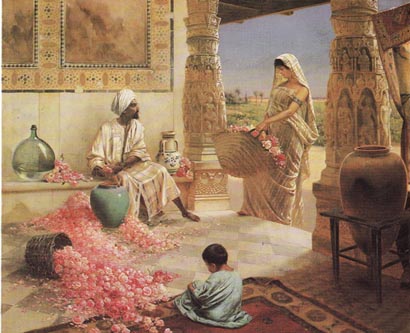
The Perfume Maker by Rudolph Ernst
I am not sure if Ittar of that quality can still be made in India, but in all the years of travelling all over the world, I have never found any perfume which could top that heady scent of raw nature at its intoxicating best.
Of the 90 employees at the Kapurthala House at the time, 63 were Muslims.
It must be noted that most of the employees at the Kapurthala House had been with the family for several generations and they considered themselves to be as much a part of our family as my father or I and had always been treated by every one in the family as such.
Almost all of the members of the Jullundur staff lived within the Kapurthala House grounds in the spacious quarters behind the house, along with their families, with the single female staff members living in the staff quarters within the main house.
There were several Mango and Shahtoot (Himalyan Mulbery) trees at the back of Kapurthala House and an ancient Peepal tree said to be over 300 years old which as I recall was great to climb up for a young boy.
So with all of the ethnic conflict going on all around in Jullundur, the Kapurthala House was still an island of harmony at that time.
One day in April of 1947 all that changed however.
The Kapurthala House Incident
In April of 1947 I was just over 3 months old and was at the Kapurthala house in Jullundur with my parents, my grandmother and my father’s younger brother Kanwar Ranjit Singh.
On Friday the 18th of April 1947, a large group of Sikhs and Hindus armed with swords and machetes gathered outside the tall iron gates of the Kapurthala House, shouting slogans against Islam and demanding that all the Muslims and their families living within the house be handed over to them.
This was an extremely shocking development, as my Grand Father, Kanwar Jasjit Singh of Kapurthala had commanded great respect from all of the leaders of the Sikh, Hindu and Muslim communities in most of Punjab.
In fact whenever there had been any serious conflict within the various communities of Punjab, specially in and around the area of Doaba, it was to Kanwar Jasjit Singh that they all turned to for the resolution of their conflicts.
Known by all simply as “Sarkar” through out the area, the word of Kanwar Jasjit Singh was always respected by all of the communities.

Kanwar Bikram Singh of Kapurthala
As far as the Sikh community was concerned, Kanwar Jasjit Singh was a desendent of Jassa Singh Ahluwalia, beloved of Guru Goving Singh Ji and the founder of one of the 12 “Misals” of the Sikhs.
His grandfather, Kanwar Bikram Singh of Kapurthala was the founder of the “Singh Sabha”, which was created by him to organise and reform the then growing problems with the Sikh Gurudwaras.
Kanwar Jasjit Singh was a favorite of Mahatma Gandhi and a close friend of Pandit Nehru and Sirdar Patel. He had held several important National and local positions such as the Chief of Indian Army Selection Board and District Magistrate of the district of Jullundur and much more.
Kanwar Jasjit Singh had passed away in 1943, only four years prior to that time and so for a Sikh and Hindu mob to gather in front of his house would have been considered to be a great insult to his name and in normal times would have been unthinkable.
The two “chowkidars” guarding the house closed and locked the iron gates and my father and his younger brother came out to the gate with a large number of the male members of the Kapurthala House staff joining them, crowding around the gates from the inside, confronting the armed gang outside of the gates.
All of a sudden there was a disturbance and to the astonishment of every one on both sides of the iron gates, the tall and statuesque figure of my grandmother, clad completely in white and followed by a number of her staff, strode to the Iron gates and ordered that the gates be opened.
Bebe Golhan had come down from the house with my grandmother and was witness to this extraordinary event.
In the words of Bebe Golhan, you could have heard a pin drop, as every one of the sword and machete wielding crowd outside the house was stunned in to silence.
My grandmother again ordered the hesitating chowkidars to open the gates immediately.
As the large iron gates were opened, my grandmother walked out of the house on her own, ordering everyone else to stand back, to go right in to the midst of the gathered mob that rapidly moved apart to make space for her.
“ki chane ho?” (what do you want) she roared, slowly moving her head from right to the left looking directly at each one of the gathered men.
Bebe Golhan said that for almost a minute no one spoke with every one of the armed men moving back slightly in a nervous subconscious movement.
“Bolo ki chahne ho” (Speak up. What do you want?) She loudly asked again.
After a few moments, one of the men hesitatingly with his eyes looking down at the ground said “Rani Sab asi ta Musalmana lai aye ha”. (Rani Sab we are here for the Muslims)
“Ki kehna hai? Uccha bol. Too mere bacchean noo maran lai aya hai?”
(What did you say? Speak up. Are you here to kill my children?) She thundered, looking directly at the man who had spoken.
Another man in the gathered crowd quickly spoke up then “Na Ji Rani Sab asi ta siraf Musalmana lai aye ha” (No Rani Sab we are here only for the Muslims).
Bebe Golhan said that at this my grandmother turned her head to look directly at the second man who had spoken up and the recipient of her glare seemed to shrink ever so slightly at that.
After a brief pause, she addressed the entire mob, in a strong but totally calm voice
“Nahi. Tusi sare mere bacchean lay aye ho. Is ghar which sab mere bacche han te main onadi maa ha. Mere kisi vi bacche noo hath lan to pahele mainoo cutna paiga”
(No you are all here to harm my children. All who live in this house are my children and I am their mother. Before you touch any of my children, you will have to kill me.)
No one said anything to that and after a brief pause, she said to all of them in a much softer voice, as if to an errant child “Chalo hun tusi sare apne ghar jao”
“Come on now, all of you go back to your homes”
Bebe Golhan said that all of the fierce men who were shouting and wielding swords and machetes only a short while back, as one turned around and quietly shuffled away.
A potentially major tragedy had been averted on that day because of the quick and decisive action taken by my grandmother.
It was clear however, that the members of the Muslim staff at the house would no longer be safe at Jullundur.
To the new border
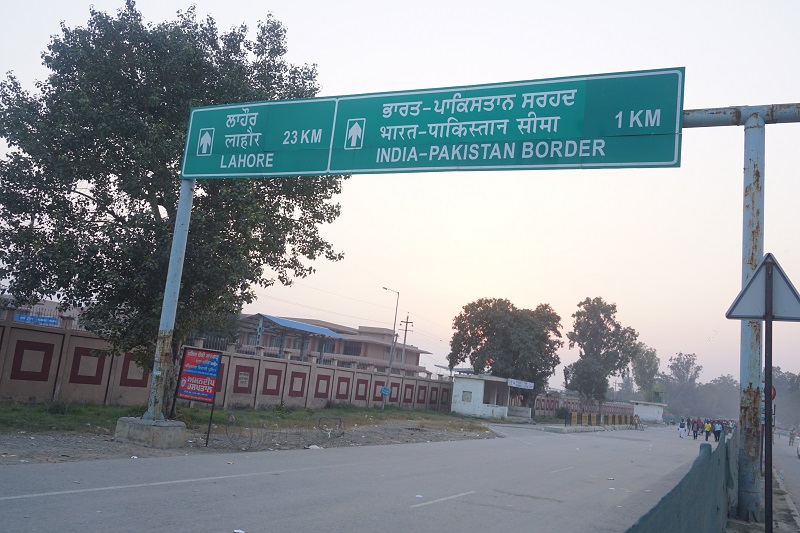
Indo-pakistan Border
Following the Kapurthala House incident, all of the Muslim members of the staff were asked to decide if they wanted to go to Pakistan or to stay with the family in India.
Only 36 of the staff decided to migrate to Pakistan and rest of the Muslim staff wanted to stay in India.
Those who wanted to stay with the family in India, were sent along with their families to our estates in Sitapur near Lucknow, which was a much safer place for Muslims at that time.
Thus the total number of the staff who wished to leave for the newly created border at Amritsar on the way to Pakistan, Including their families came to 72 persons.
It was very dangerous to travel to any place in the Indian Punjab if you were a Muslim at that time, but it was especially so, to try and travel from Jullundur to Amritsar on the way to the new border of India/Pakistan.
Armed gangs of Hindus and Sikhs roamed the roads leading to Amritsar, looking for Muslims on the way to Pakistan, bent on revenge for the murder of their loved ones on the other side of the border.
Muslim men were being hacked to death on the spot and Muslim women were taken away by the gangs.
In June of 1947 my father and his uncle Sirdar Himmet Singh had recovered three Muslim girls from the village of Anipur in Jullundur.
These girls were the nieces of Zafar Sharif, the khansama (chief cook) at Kapurthala House and had been abducted by a gang of Hindus and Sikhs.
My father and his younger brother Kanwar Ranjit Singh decided to personally escort all the staff who wished to go to Pakistan along with the members and their families to the new border at Amritsar in safety.
This had to be planned carefully as Muslim families travelling on the Jullundur to Amritsar road were regularly being dragged out of cars and buses and killed on the spot.
The local security forces at the time were not at all reliable and many members of the security forces had been killing the Muslims who were trying to get to the border with Pakistan.
The trunk (boot) of my father’s Buick car was enlarged and extended under the back seats, to create a reasonably comfortable space for up to two adults, with thick padding (my grandmother’s eiderdown–quilts!) all around the extended space.
The plan was for my father to drive all the Muslim staff of Kapurthala House who wanted to migrate to Pakistan in his Buick to the border at Amritsar .
My father would drive the car and his younger brother Kanwar Ranjit Singh was to sit “shotgun” next to him in the front seat, both of them armed and in Army uniform with up to four adults or two adults and two children seated at the back seat of the car.
The most important part of the plan though, was the idea of dressing up the Muslim staff and their families as Nihang Singhs (the ancient warrior sect of the Sikhs) with their distinctive blue and yellow clothing, full flowing beards, Dastar Bunga (high turban) and all the traditional weapons.

A Fabulous Nihang Singh Warrior with his Sons
This idea was especially useful for the women in the families of the Muslim staff as a Nihang woman “Singhni” is considered to be a ferocious warrior and not to be lightly messed around with!
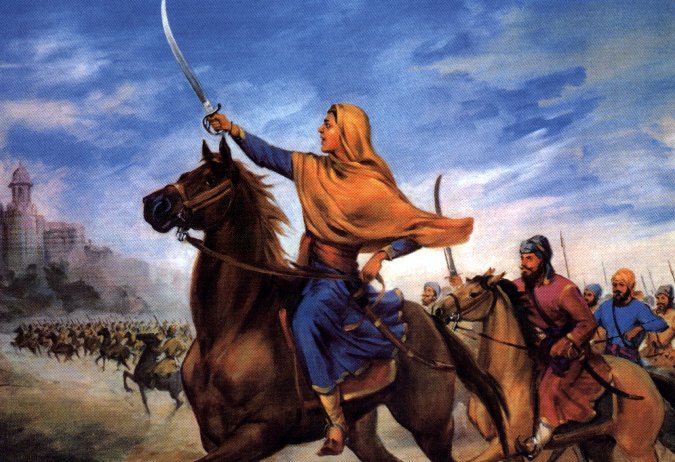
A Formidable Nihang Singhni
So in the back seat there would be up to 4 adults (or two adults and two children) all of them dressed as Nihang Singhs, in addition to up to two adults hidden in the trunk of the car, if needed.
In spite of all the risks involved, the plan worked perfectly as apparently none of the armed gangs wished to entangle with a car load of Nihang Singhs and Singhnies driven by two armed Army walas!
All of the members of the Muslim staff of the Kapurthala House, who had wanted to go to Pakistan along with their families, were safely transported to the border over a period of 18 days using my father’s modified Buick.
Rajkumai Amrit Kaur and Lady Mountbatten
The situation in the rest of India got worse over the coming weeks though, as an ever larger number of stranded people on both sides of the border were hunted down by mobs blinded by their own pain of the murders of their kin folks across the border.
The lucky ones, who were able to make their way to their new country, had lost all their possessions. They found themselves homeless in a strange land, in most cases with only the clothes that they had on when they had to leave their homes.
On 15th of August 1947, India became an independent country.
All of the national leaders who had fought for the independence for so long were present at the ceremony in Delhi, which was headed by Lord Mountbatten, who had agreed to remain the Governor General for a bit longer and by Pandit Nehru, the first Prime Minister of India.
Only Mahatma Gandhi, the spiritual leader of the free India movement and the father of the country, was not present at the ceremony.
He had instead decided to go over to Bengal on that day, to organise camps for the refugees who were pouring into India from what was now West Pakistan.
The extent of the problem of millions of refugees arriving in to India from the East and the West had not been foreseen by any one.
Rajkumai Amrit Kaur, my father’s aunt was a good friend and a disciple of Mahatma Gandhi and it was to her that he turned to take charge of the refugee problem.
I believe that Mahatma Gandhi asked Pundit Nehru the Prime Minister of India, if he could borrow his new Health Minster for a short while, to see if she could help solve the growing refugee problem to and from India !
That is how Rajkumari Amrit Kaur, the first Minister of Health of the Government of India, as well as the first woman member of the Prime Minister’s Cabinet, took on one of the first great challenges that the newly formed Government of India had to face.
Lady Mountbatten who had also been greatly affected by the plight of the refugees asked Mahatma Gandhi if she could help and joined Rajkumari Amrit Kaur in her efforts for the refugees.
The refugee situation in India was of course a two way problem.
There was shelter, food and even clothing to be found for the very large number of Sikhs, Hindus, Christians, Buddhists, Jains and others arriving in India from Pakistan, as most had lost all their worldly goods.

Rajkumari Amrit Kaur of Kapurthala
But there were also tens of thousands of Muslims still trapped in India, who were trying to get across the border without getting killed by the revenge mobs of Hindus and Sikh, who were looking for them on the roads leading to the border.
Rajkumari Amrit Kaur and Lady Mountbatten were therefore responsible for not only the care and well being of the refugees arriving in India, but also for the safety of the Muslims on the way to Pakistan.

Tents at Kingsway refugee Camp, Delhi
The first important task was to set up suitable refugee camps.
My grandmother was one of the first people approached by Rajkumari Amrit Kaur to request that Kapurthala House in Jullundur be established as a refugee camp and of course she immediately agreed to do so.
Thirty Six large tents were put up in the grounds of the Kapurthala house with food prepared daily for the refugees, by the vegetarian and the non vegetarian kitchens in the house.
Since Rajkumari Amrit Kaur was the first Health Minister of the Government of India, a very good medical clinic was quickly established in the Kapurthala House, next to the refugee tents, manned by two doctors and several nurses etc to provide medical attention needed by the refugees.
On Tuesday the 26th of August 1947, Rajkumari Amrit Kaur and Lady Edwina Mountbatten visited the Kapurthala House refugee camp as part of their tour of the refugee camps in Punjab over a period of two days.
Unlike other camps that they visited during the tour, Kapurthala House in Jullundur belonged to Rajkumari Amrit Kaur’s her own family and so it was an informal visit and almost like a break in the tough two day schedule.
So the visit to Kapurthala House in Jullundur was a lot more relaxed and they even found time for tea with my grandmother, my father, his younger brother Kanwar Ranjit Singh and my mother.
I believe that I was brought in at some stage by Ladlee, my aya, (Indian nanny) in order to introduce Rajkumari Amrit Kaur to her brand new grand nephew.
During the tea, the conversation moved to the vital new work regarding the refugees from both sides of the border and Lady Mountbatten mentioned the increasingly difficult and dangerous situation related to the Muslims who were trying to get to the border and then on to Pakistan.
My grandmother then told them as to how a similar problem with the Kapurthala House staff had been solved by my father and his brother, by driving the Muslim staff and their families dressed as Nihang Singhs in my father’s Buick, escorted by the two brothers in Army uniform.
Both Lady Mountbatten and Rajkumari Amrit Kaur were fascinated by the story of the safe transportation of the Kapurthala House staff and their families to the border and wanted to discuss this further with my father and my uncle.
My father and his brother were then invited to come over to Delhi as soon as they could, to see if their experiences could help in solving the problem of the Muslims trapped in India.
When my father and my uncle drove down to Delhi for their meeting at Raj kumari Amrit Kaur’s office at the Ministry of Health, they were astonished to find Mahatma Gandhi along with Sirdar Patel not only present at the meeting, but also fully involved in all aspects of the refugee problem.
Lady Mountbatten had that very day produced a devastating report after visiting the border areas in India and in Pakistan, drawing a grave picture of the situation facing the refugees in both countries.
She said that the refugees were “in a state of mass hysteria” with neither side trusting the other in any way whatsoever.
Most worryingly, she reported a complete lack of confidence in the Punjab Boundary force.
The Punjab Boundary force or the border petrol force, comprised of 15 Indian and 10 Pakistani battalions and was commanded by General Rees.
The PBF had been created by the British as almost their last act in India, to try and keep some semblance of order during those tumultuous times.
Lady Mountbatten had been told that many members of the Punjab Boundary force in India were suspected as being part of the gangs who were killing Muslims where they could find them.
Few days after Lady Mountbatten’s report, on September 1st the Punjab Boundary force was disbanded.
On the Pakistan side, the situation was even worse for Hindus, Sikhs and other non Muslims as the Muslim League was now openly using sections of the Pakistani armed forces to find and kill stranded Non-Muslims in Punjab.
There had even been instances reported where some Sikh communities had been bombed from the air!
This outrage resulted in what is said to be the very first official protest lodged against Pakistan by Pundit Nehru.
Mahatma Gandhi had been impressed with what Rajkumari Amrit Kaur and Lady Mountbatten had told him. He and Sirdar Patel asked my father and his brother detailed questions about the way that the Muslim employees of the Kapurthala House in Jullundur had been safely taken to the border at Amritsar in my father’s car dressed as Nihang Singhs.
Mahatma Gandhi had been very upset about the problems faced by all the refugees and said to my father “I am the cause of all the pain and suffering for each and every refugee from India or from Pakistan”.
As the first Home Minister of India, Sardar Vallabhbhai Patel was responsible for the security and relief efforts for the Muslim refugees trying to get to the border of Pakistan as well as the welfare of non Muslim refugees still in Pakistan.
Sirdar Patel said that because of the growing ethnic tension in the border region of Punjab, it was not possible for Muslim refugees to openly travel in trains and buses to try and get to the border.
He said that the Home office also suspected complicity of the security forces with armed gangs roaming the roads leading to the border, making it difficult to involve the local police and security forces to help with the task.
Some of the available Indian troops were being used to transport the Muslim refugees to the border at Amritsar in Army trucks, but there was severe shortage of troops and army tucks.
Gandhi Ji then said that it would be a great help if some of the Muslim refugees could secretly be transported to the border in the same way as the Kapurthala House staff and their families had been taken to the Border at Amritsar.
Muslim families in and around the Doaba area (Jullundur, Kapurthala, Ludhiana etc) who wanted to get to Pakistan could be sent over to the Kapurthala House and from there be taken to the border.
My father and Ranjit Chacha Ji were of course delighted to help in any way that they could and said so.

Another 9 large automobiles were made available for the project by several VIPs at Mahatma Gandhi’s request.
My father got a dozen family members and close friends to drive the cars as well as sit “shot gun” for the additional cars.
My father’s cousin Kanwar Satyajit Singh (Manni Chacha Ji) got a Rolls Royce from one of his friends and drove it himself several times from Jullundur to Amritsar to personally deliver many Muslim families to the border.
Over many months, a large number of Muslims families waiting to go to Pakistan were safely taken to the border, using the Buick and the other cars, dressed as Nihang Singhs, Singhnis and Nihang Kids!
Only once during all this time was any of the cars stopped by an armed road gang looking for Muslims.
The driver of that car at the time happened to be Sirdar Himmet Singh, my Grandmother’s younger brother, whom I recall as a most ferocious looking, 6 feet 3 inches tall Sikh, with very broad shoulders, a flowing jet black beard and very scary piercing eyes.
So it was not at all surprising that when he stepped out of the car, with his customary huge Kirpan (Sikh sword) casually tucked into the bright yellow cloth belt around his waist, the car was allowed to go on without any arguments of any kind.
615 Express

Pandit Jawarharlal Nehru’s first cabinet, with Rajkumari Amrit Kaur & John Mathai seated 2nd and 4th from the right
Even though John Mathai was not formally designated as the Railways Minister of India in the first Nehru cabinet, it was he who was basically in charge of the Indian railways during 1947, in its first year of operation.
John Mathai had his work cut out though, as the Indian railways had been greatly damaged due to the extraordinary demands on its operations during the Second World War.
The incredibly violent events related to the partition were causing further devastation, in addition to the fact that a large part of the network (North Western Railway and Bengal Assam Railway) had been handed over to Pakistan.
Not surprisingly therefore, the first year of the Indian Railways was constantly full of problems of one kind or another.
During a meeting of John Mathai with Pandit Nehru at the PM house, Mahatma Gandhi was also present, along with Rajkumari Amrit Kaur.
Pandit Nehru had been complaining about the unreliability of the trains, specially the trains to the two borders of India with Pakistan, while John Mathai was trying to argue that the things were not as bad as that.
Pandit Nehru then angrily said “All right then, give me one example of a service anywhere in the country, which is completely reliable and is always on time”
At this, in order to diffuse the rising temperature of the conversation, Mahatma Gandhi chipped in to the conversation with a huge big smile on his face, “I can tell you of a service which is 100% reliable and is always on time”.
Pandit Nehru and Jhon Mathai both turned with a surprised look towards Mahatma Gandhi, who said “615 Express from Jullundur to Amritsar is 100% reliable and is never late”.
John Mathai looked confused and was about to say that he did not know of any such service, when Mahatma Gandhi proceeded to tell the story of how Rajkumari Amrit Kaur had arranged with her two nephews to drive Muslims families wishing to go to Pakistan from Jullundur to Amritsar in secrecy and safety, dressed as Nihang Singhs and that they had already transported hundreds of Muslim families over to the border at Amritsar.
He then told them about the number plate of my father’s Buick car which was PNJ 615 and that he had called the secret transportation service “615 express”, ending his story with his customary loud and very infectious laugh, which according to Rajkumari Amrit Kaur, made everyone in the room smile.

